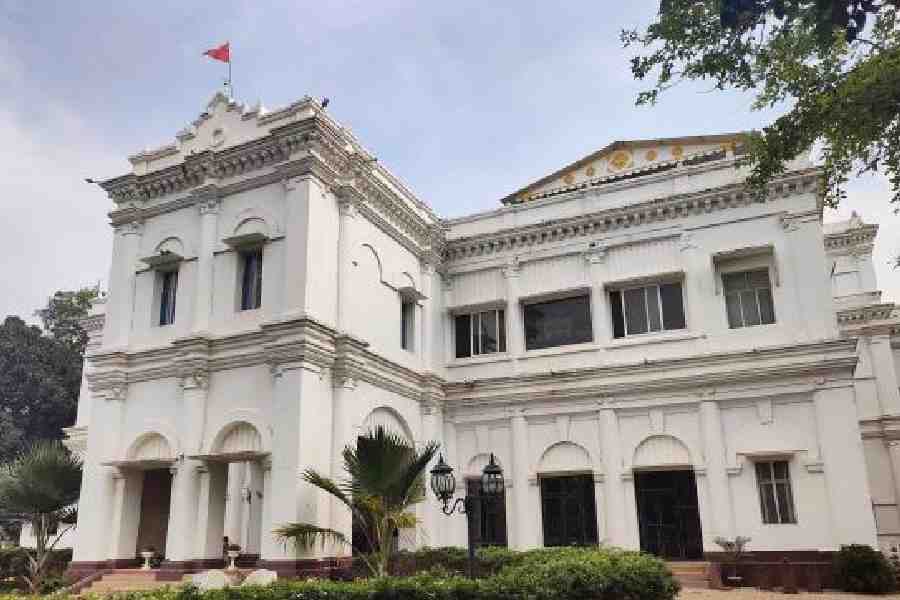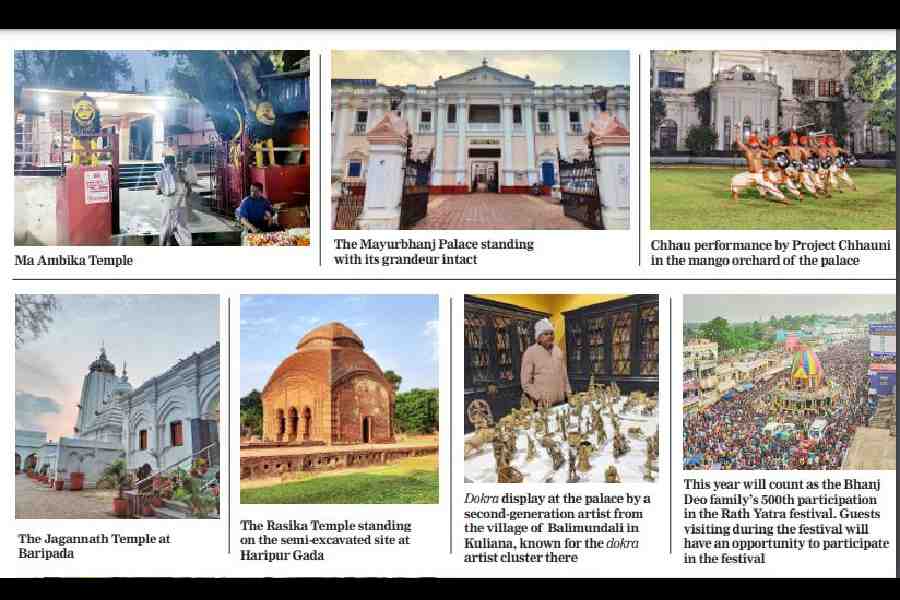Just a four-hour drive from Calcutta and we were in for a treat with a royal getaway in a recently spent weekend in Odisha’s largest district, Mayurbhanj. We started early in the morning from south Calcutta, made a brief stop for breakfast at a Kolaghat dhaba and by afternoon a grand welcome awaited us at Mayurbhanj’s only boutique hotel, The Belgadia Palace, the royal residence of the Bhanj Deos of the Bhanj dynasty.
Presently being resided by the 46th, 47th and 48th generations of the Bhanj Deos belonging to Maharaja Pratap Chandra Bhanj Deo’s lineage, the elegant Victorian-style palace in white is situated in an 18-acre property surrounded by the family-owned lake and fruit orchards, which made our stay at the palace extremely pleasant, despite the uncomfortable weather. Built in the 1800s as a residence of Maharaja Sri Ram Chandra Bhanj Deo’s second wife, Sucharu Devi, and a guesthouse for guests of the Mayurbhanj Palace, the residence of the royal family back then, a part of the 200-year-old palace was only recently renovated as a hotel in September 2019 by its 48th generation, sisters Mrinalika and Akshita, the princesses, who presently reside in the residential wing of the palace. Coming back to their hometown after completing studies in the US, the treasure trove of art, architecture, culture and various artisan communities that their hometown is, fascinated the sisters and inspired them to embark on a journey to promote Mayurbhanj as a tourist destination by hosting relaxed vacations and arranging a variety of local tours for guests, like community tour, experiential tour, nature tour and many more.
The two-day itinerary designed for us was a mixed bag starting with a visit to the sabai grass handicraft production centre, run by the Bathuri tribe at Guhaldihi village, post an elaborate thali lunch on the day of our arrival. “There is a folklore that Maharaja Sri Ram Chandra Bhanj Deo went to Madagascar for a hunting game and saw the sabai grass for the first time. He noticed how it creates livelihood. People can create things out of it and earn. It was always a women-dominated work, and the lady who started this cluster is Usha Rani. She decided to make money on her own and was joined by the women weavers of the Bathuri tribe,” informed Mrinalika during our dinner later in the evening. She further added, “The sabai grass is 100 per cent sustainable and biodegradable. Earlier, they used to make only ropes, but now they make a variety of useful products for the 21st century. During the pandemic, their livelihood was affected, and that is when my sister and I decided to open a boutique in our palace to house their products to help them continue earning their livelihood. But even then, when guests come, we direct them to visit their production unit to get an experience of the local artisanal community in our attempt to promote them.”
On our way back to the palace in the evening, our car made a brief stop at the scenic Badjod dam for us to catch a glimpse of the riverside sunset along with some fresh air, before taking us to the erstwhile residence of the Bhanj Deos — the grand Mayurbhanj Palace that now serves as an educational institution like most of the dynasty’s palaces. ”Mayurbhanj Palace was built in the 1800s following the orders of Maharani Sumitra Devi, one of our ancestors. After marriage, my grandmother also lived there. It was given away in the 1950s to be an educational institute like most of our summer palaces. Our great-grandfather thought the only way humans can be liberated is through education and so this was a goal in life for him. It is now known as Purna Chandra College,” said Mrinalika.
Another stop on our way back was the Ambika temple, a 10-minute walking distance from the Belgadia Palace. The locals consider this ancient temple as a temple of ‘The Living Goddess’. The evening high-tea greeted us back at the palace, followed by an early dinner of local and royal delicacies over a conversation with Mrinalika, who regaled us with stories of the palace and the royal family. Before calling it a day, we were lucky to be greeted by Mrinalika’s pets, our four-pawed furry hosts at the palace.
Day two started on a leisurely note with breakfast on the bed — a platter of fresh fruits, south Indian delicacies, omelette and fresh mango-banana juice. The palace tour with Mrinalika kept us occupied the entire morning. “The family now lives in the two wings of the property and the rest is divided into guest rooms and leisure rooms. Now, we host guests throughout the year. Structurally, we didn’t renovate the palace. The property used to have a pastel colour palette but then I wanted to go ahead with the Wes Anderson theme of turquoise, red and a mix of bolder shades. We re-organised the artefacts to make it more guest-friendly. This palace as the former guesthouse of the royal family hosted the likes of Rabindranath Tagore, Keshab Chandra Sen and Annie Besant. This was the last district to sign in with Odisha. Our ancestors had the dream of keeping it as an independent state as many different communities lived here. We still have a copy of the last independent state calendar of the year 1948. Even the marble table on which the treaty of accession of Mayurbhanj to Odisha was signed sits in our ballroom converted into the living room,” informed Mrinalika during our palace tour.
Stories of the family’s connection to West Bengal, where Maharaja Sri Ram Chandra Bhanj Deo often stayed with his wife Sucharu Devi at their Mayurbhanj Road palace, Sucharu Devi being deprived of the ‘Maharani’ title and the emblem of the palace of two peacocks holding a crest accompanied us as we marvelled at the architectural brilliance and spotted many historical artefacts scattered around the palace. “Mayurbhanj refers to the land of the peacocks and perhaps that is why the design of the emblem is that… my grandmother used to keep peacocks as pets and they used to feed off her hands. She could train them like dogs,” laughed Mrinalika.
After lunch, crossing vast acres of paddy fields and catching a view of the Simplipal range at a distance, we went on a royal guided tour to the brick-built Rasika temple at Haripur Gada, the capital of erstwhile Mayurbhanj state. Our next stop was the Jagannath temple of Baripada constructed by Maharaja Baidyanath Bhanj Deo. The site was an interesting visit as the making of the wooden chariots was underway to celebrate the biggest festival of the state, the Rath Yatra.
A customary arrangement for the guests, the cultural evening at the palace was kept as the last experience of the tour for us. It was a chilled-out evening spent in the breezy mango orchard of the palace, watching a performance of the Mayurbhanj Chhau dance and an opportunity to interact with a dokra artist to know more about the local craft and maybe also pick up a few souvenirs before leaving for home. “We have collaborated with Project Chhauni, an NGO trying to revive the Mayurbhanj Chhau dance, to offer this experience to our guests. The dance originated here, inspired by the rebellious activities that used to happen back in those days. Local people used to prepare for warfare by deceiving the British rulers and calling it a dance of swords and shields. Maharaja Sri Ram Chandra Bhanj Deo patronised this art form and it was performed in front of King George V during his visit to Calcutta.

The Belgadia Palace
It is different from the Purulia Chhau as the dancers don’t wear their masks in it. Only in recent years, women have been participating in it. Many of the sequences of the dance form are lost now as they were not documented initially and most of the gurus are also not alive. It is an interesting journey for the family to be a part of its revival,” said Mrinalika. The performances were followed by a buffet dinner in the specially decorated dinner hall. “When I started staying in Mayurbhanj, I came across the village clusters and various art forms. We wanted to push it out to the global market. The community exists for us and we exist because of the community. There is a synergy. When we started Belgadia, we knew what we wanted to achieve. The journey has always been to bring Mayurbhanj on the map. JRD Tata started the TATA industry from Mayurbhanj, Hemendranath Majumdar painted some paintings and left them here. Apart from the historical, architectural and artisan community experiences, Simplipal Forest is a UNESCO-recognised national park and the entry gate is just 30 minutes from Belgadia. It has beautiful nature experiences inside. But there was no place for a person to stay here, so we started Belgadia. A place like this needs world recognition,” explained Mrinalika about her vision, before we left for Calcutta the next morning after our two-day sojurn.


